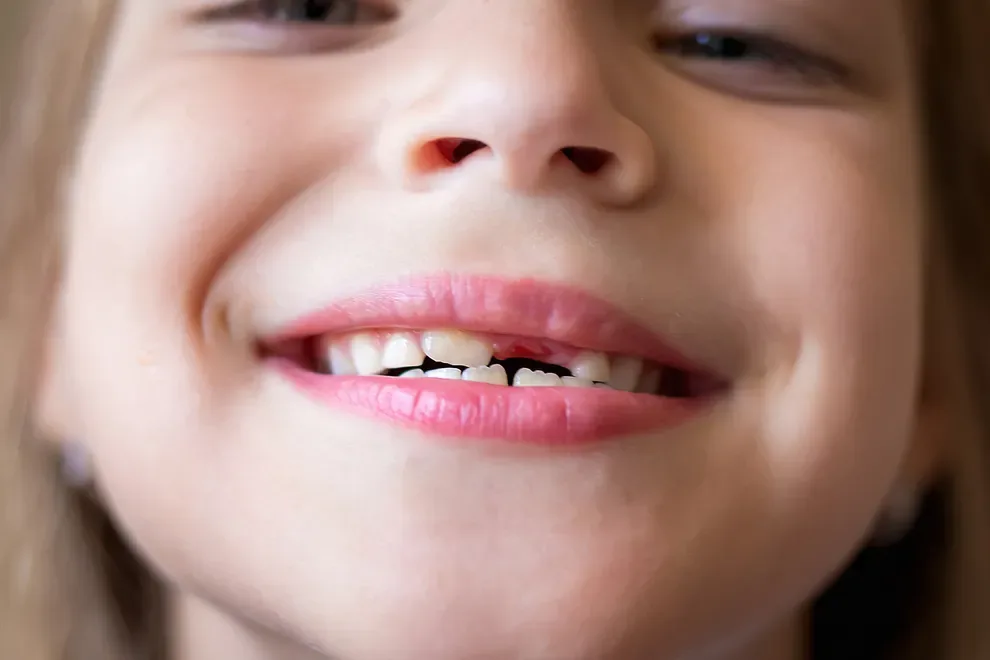The Transition from Baby to Adult Teeth: Expectations & Management

Table of Contents
- Teeth Growth Tracking
- Teeth Transition Overview
- How to Keep Children's Teeth Healthy
- Teeth Straightening & Orthodontics
- Frequently Asked Questions
- References
You can expect your child’s transition from baby teeth to adult teeth to last their entire childhood. Their baby teeth will begin falling out around age 6 and continue falling out into their early teen years.
Over time, adult teeth will replace baby teeth, also called primary teeth. Caring for your child’s baby teeth properly and starting teeth straightening treatments at the right time will ensure that your child ends up with a full set of straight adult teeth.
Tracking Teeth Growth Through Eruption Charts
Children’s baby teeth start appearing sometime between 4 and 10 months of age. This process is influenced by many factors, so don't be alarmed if your child starts developing baby teeth earlier or later than this.
Teeth eruption charts are handy tools to help you track your child’s dental development. Remember that the chart is merely a guide: not every child's teeth will erupt at the same time.
To use the eruption chart, mark the date when your child’s first tooth emerged. Then, use this date as a reference point for when the other teeth should appear. Most children will have 20 baby teeth in total. In general:
The first four teeth appear around 6 months of age.
Teeth appear in pairs, one on each side of the jaw.
Lower teeth erupt first.
Baby teeth are whiter and smaller compared to permanent teeth.
Primary to Adult Teeth Transition Overview
The transition from baby teeth to permanent ones is slow and gradual, lasting from before birth to around age 18. It progresses in 5 stages:
Stage 1: Infancy to age 3
Stage 2: Ages 3 to 6
Stage 3: Ages 6 to 9
Stage 4: Ages 9 to 12
Stage 5: Ages 12 to 18
While teeth first appear when a child is about six months old, the teeth begin to develop around six weeks into the pregnancy.
The first teeth to appear are the lower front teeth, followed by the front teeth on the upper jaw. This process continues until the child has all 20 baby teeth by age 3.
Pediatric dentists advise parents to take their child for their first dental appointment when the child is around 1 year old.
At this stage, your child begins to develop their adult molars. These molars grow under the gums at the back of the mouth just behind the premolars. Dentists also advise you to consider sealants for children in this age range to prevent cavities.
Your child will lose their first primary teeth at this stage. The lower central and lateral incisors will loosen and fall out before being replaced by permanent ones. Their adult first molars will also erupt at the back of their mouth.
By this point, most of your child’s baby teeth will be gone. Their adult canines and premolars will erupt from both jaws. Some children’s permanent second molars will also erupt behind the first set.
Your child should lose the last of their baby teeth during the first few years of this stage. Some teenagers may also develop a third set of molars (also known as wisdom teeth).
Depending on whether their wisdom teeth have erupted, your child will now have a full set of 28 to 32 adult teeth.
How to Keep Your Child's Teeth Healthy
Some parents neglect to care for their child's primary teeth since these teeth will eventually fall out. However, caring for baby teeth allows your child to chew and speak without difficulty. In addition, keeping baby teeth in place as long as possible allows them to act as placeholders for the permanent teeth. This keeps the rest of the teeth in proper alignment until the permanent tooth is ready to erupt.
You can take care of your child’s primary teeth by:
Wiping the gums with a soft cloth before teeth erupt
Using a soft toothbrush and plain water to clean the first teeth to erupt
Visiting a pediatric dentist when your child is 1 year old
Using a soft toothbrush and a pea-sized amount of children’s toothpaste when your child is 2 years old or older
Flossing your child’s teeth when they have at least two teeth that touch each other
Switching to normal toothpaste when your child 6 years old or older
Supervising your child while they are brushing until you are confident that they can do it correctly
When Should You Consider Teeth Straightening and Orthodontics?
During your child’s routine dental visits, the dentist will assess the alignment of your child’s teeth and tell you if orthodontic treatment is required.
If your dentist recommends orthodontic treatment, take your child for a consultation when they are around 7 years old. The orthodontist will assess their case and determine whether treatment should begin immediately or if a delayed approach is best.
There are many different options available to straighten teeth, including:
Metal braces
Ceramic braces
Lingual braces
Your child’s orthodontist will let you know which options are best suited to your child’s needs and lifestyle.
Frequently Asked Questions
Baby teeth usually appear when a child is between six months and 3 years old. Starting at age 6, these teeth begin to fall out and are replaced by permanent (adult) teeth.
Once the primary tooth falls out, it takes about six months for the permanent teeth to erupt. Molars and back teeth take longer than front teeth. If the tooth is extracted early due to damage or decay, it may take much longer.
Most people have 20 baby teeth that eventually fall out to create space for permanent teeth. An additional 12 teeth erupt during the transition, leaving each person with 32 adult teeth.
